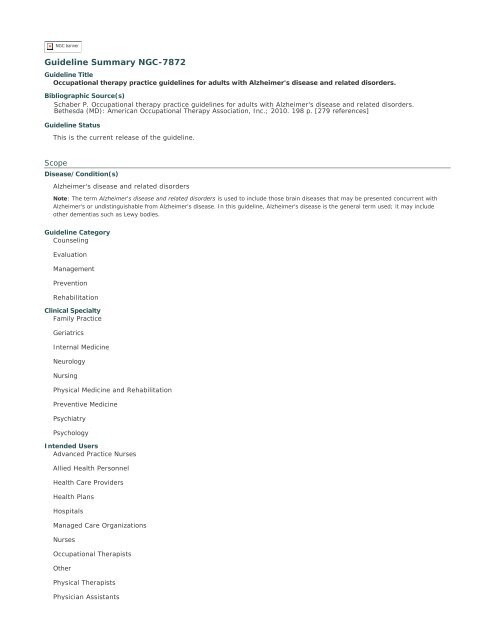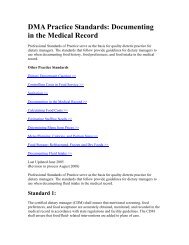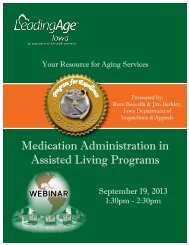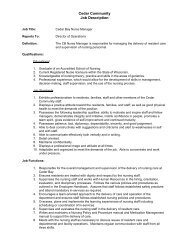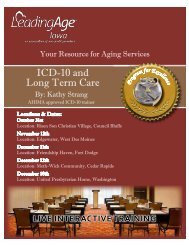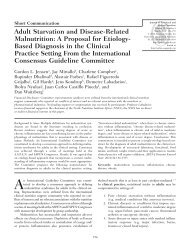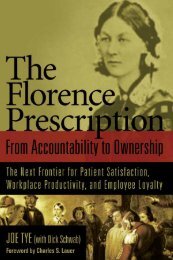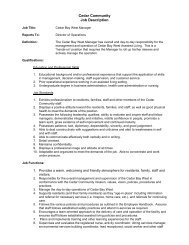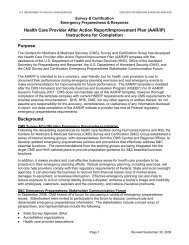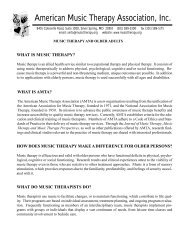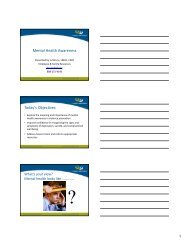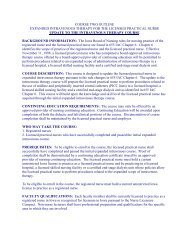Occupational Therapy Practices - Iowa Association of Homes ...
Occupational Therapy Practices - Iowa Association of Homes ...
Occupational Therapy Practices - Iowa Association of Homes ...
Create successful ePaper yourself
Turn your PDF publications into a flip-book with our unique Google optimized e-Paper software.
NGC bannerGuideline Summary NGC-7872Guideline Title<strong>Occupational</strong> therapy practice guidelines for adults with Alzheimer's disease and related disorders.Bibliographic Source(s)Schaber P. <strong>Occupational</strong> therapy practice guidelines for adults with Alzheimer's disease and related disorders.Bethesda (MD): American <strong>Occupational</strong> <strong>Therapy</strong> <strong>Association</strong>, Inc.; 2010. 198 p. [279 references]Guideline StatusThis is the current release <strong>of</strong> the guideline.ScopeDisease/Condition(s)Alzheimer's disease and related disordersNote: The term Alzheimer's disease and related disorders is used to include those brain diseases that may be presented concurrent withAlzheimer's or undistinguishable from Alzheimer's disease. In this guideline, Alzheimer's disease is the general term used; it may includeother dementias such as Lewy bodies.Guideline CategoryCounselingEvaluationManagementPreventionRehabilitationClinical SpecialtyFamily PracticeGeriatricsInternal MedicineNeurologyNursingPhysical Medicine and RehabilitationPreventive MedicinePsychiatryPsychologyIntended UsersAdvanced Practice NursesAllied Health PersonnelHealth Care ProvidersHealth PlansHospitalsManaged Care OrganizationsNurses<strong>Occupational</strong> TherapistsOtherPhysical TherapistsPhysician AssistantsPhysiciansPsychologists/Non-physician Behavioral Health Clinicians
OtherPhysical TherapistsPhysician AssistantsPhysiciansPsychologists/Non-physician Behavioral Health CliniciansSocial WorkersUtilization ManagementGuideline Objective(s)• To provide an overview <strong>of</strong> the occupational therapy process for adults with Alzheimer's disease and relateddisorders• To define the occupational therapy domain and process and interventions that occur within the boundaries <strong>of</strong>acceptable practice• To help occupational therapists and occupational therapy assistants, as well as the individuals who manage,reimburse, or set policy regarding occupational therapy services, understand the contribution <strong>of</strong> occupational therapyin treating adults with Alzheimer's disease and related disorders• To serve as a reference for health care pr<strong>of</strong>essionals, health care facility managers, education and health careregulators, third-party payers, and managed care organizationsTarget PopulationAdults with Alzheimer's disease and related disorders and their caregiversInterventions and <strong>Practices</strong> Considered1. Referral for occupational services2. Evaluation• Developing the occupational pr<strong>of</strong>ile• Analysis <strong>of</strong> occupational performance through observation and assessment3. Intervention process• Developing an intervention plan• Intervention implementation through creating, restoring, maintaining, modifying, and preventing deterioration<strong>of</strong> occupational performance• Intervention review• Developing interventions related to areas <strong>of</strong> occupation, performance skills and performance patterns, contextsand environments, activity demands, and client factors4. Discontinuation <strong>of</strong> service5. DocumentationMajor Outcomes Considered• Performance skills• Performance patterns• Quality <strong>of</strong> life• Health• Client or caregiver satisfactionMethodologyMethods Used to Collect/Select the EvidenceHand-searches <strong>of</strong> Published Literature (Primary Sources)Hand-searches <strong>of</strong> Published Literature (Secondary Sources)Searches <strong>of</strong> Electronic DatabasesDescription <strong>of</strong> Methods Used to Collect/Select the EvidenceSeven focused questions were developed for the evidence-based literature review <strong>of</strong> occupational therapy interventionsfor adults with Alzheimer's disease. The questions were generated in conjunction with a group <strong>of</strong> content experts inAlzheimer's disease and evidence-based practice. They were developed and reviewed to provide needed information toupdate the previously published guidelines for the practice <strong>of</strong> occupational therapy for adults with Alzheimer's disease.The following focused questions were included in the review:1. What is the evidence for the effect <strong>of</strong> interventions designed to establish, modify, and maintain activities <strong>of</strong>daily living (ADLs), instrumental activities <strong>of</strong> daily living (IADLs), leisure, and social participation on the quality <strong>of</strong>life, health and wellness, and client and caregiver satisfaction for persons with dementia? (Areas <strong>of</strong> Occupation)2. What is the evidence for the effect <strong>of</strong> interventions designed to modify and maintain perceptual abilities on theoccupational performance <strong>of</strong> people with dementia? (Perception)3. What is the evidence for the effectiveness <strong>of</strong> interventions designed to establish, modify, or maintain routineson the occupational performance, quality <strong>of</strong> life, health and wellness, and client and caregiver satisfaction <strong>of</strong> peoplewith Alzheimer's disease? (Routines)4. What is the effect <strong>of</strong> environmental-based interventions (e.g., Montessori and Snoezelen) on performance,affect, and behavior in both the home and institutions for people with Alzheimer's disease? (Environment)
1. What is the evidence for the effect <strong>of</strong> interventions designed to establish, modify, and maintain activities <strong>of</strong>daily living (ADLs), instrumental activities <strong>of</strong> daily living (IADLs), leisure, and social participation on the quality <strong>of</strong>life, health and wellness, and client and caregiver satisfaction for persons with dementia? (Areas <strong>of</strong> Occupation)2. What is the evidence for the effect <strong>of</strong> interventions designed to modify and maintain perceptual abilities on theoccupational performance <strong>of</strong> people with dementia? (Perception)3. What is the evidence for the effectiveness <strong>of</strong> interventions designed to establish, modify, or maintain routineson the occupational performance, quality <strong>of</strong> life, health and wellness, and client and caregiver satisfaction <strong>of</strong> peoplewith Alzheimer's disease? (Routines)4. What is the effect <strong>of</strong> environmental-based interventions (e.g., Montessori and Snoezelen) on performance,affect, and behavior in both the home and institutions for people with Alzheimer's disease? (Environment)5. What is the effectiveness <strong>of</strong> interventions designed to modify the activity demands <strong>of</strong> the occupations <strong>of</strong> selfcare,work, leisure, and social participation for people with Alzheimer's disease? (Activity Demands)6. What is the evidence for the effect <strong>of</strong> interventions to prevent falls in people with dementia? (Fall Prevention)7. What is the effectiveness <strong>of</strong> educational and supportive strategies for caregivers <strong>of</strong> people with dementia on theability to maintain the participation in that role? (Caregiver Strategies)Inclusion and exclusion criteria are critical to the systematic review process because they provide the structure for thequality, type, and years <strong>of</strong> publication <strong>of</strong> the literature incorporated into a review. The review <strong>of</strong> all seven questionswas limited to the peer-review scientific literature published in English. The review also included consolidatedinformation sources such as the Cochrane Collaboration. Except as described here, the literature included in the reviewwas published since 1987, with the study populations including participants with dementia or their caregivers. Thereview excluded data from presentations, conference proceedings, non–peer-reviewed research literature, researchreports, dissertations, and theses.One team reviewed intervention questions focusing on areas <strong>of</strong> occupation, perception, and routines. These reviewsincluded literature published between 1994 and 2005. The areas <strong>of</strong> occupation review included interventions thatfocused on at least one <strong>of</strong> the following: ADLs, IADLs, leisure, or social participation. Studies were considered for thereview if they included at least one <strong>of</strong> the following outcome measures: quality <strong>of</strong> life, health, wellness, and client orcaregiver satisfaction. Articles with study samples <strong>of</strong> people with AIDS-related dementia were excluded from thereview. The perception review included studies that described and evaluated interventions that targeted perception,either improving or maintaining perception, or using remaining perceptual abilities. In addition, studies included in theperception review reported functional or occupational performance outcomes. The routines review included studies thatdescribed an intervention on the basis <strong>of</strong> the use <strong>of</strong> routine, described responses to the use <strong>of</strong> routine in the course <strong>of</strong>daily care, or described interactions during routines. Studies were excluded from the review if there was no report <strong>of</strong>data or systematic observations <strong>of</strong> the outcomes <strong>of</strong> the use <strong>of</strong> routines. For all three reviews, the following databaseswere searched: AgeLine, CINAHL, Medline, PsycInfo, EMBASE, and HealthSTAR. In addition, the Cochrane Library, OTSeeker, and Allied and Complementary Medicine were searched for the perception and routines questions.Bibliographies <strong>of</strong> selected studies in all three reviews were hand searched to locate additional potential articles. Teammembers developed the search strategies, and a research librarian with a specialty in rehabilitation science wasconsulted to finalize the search strategy. Table D2 in the original guideline document presents the search strategies forall three reviews. A team member conducted the searches, and review members discussed the search results to ensurethat key articles or areas <strong>of</strong> research had not been overlooked and that articles met the inclusion criteria. Groupconsensus was used to resolve any uncertainties. For the review focusing on areas <strong>of</strong> occupation, 6,621 titles andabstracts were reviewed, and 291 articles were reviewed in full. Twenty-six articles fulfilled the inclusion and exclusioncriteria for the review. A total <strong>of</strong> 3,766 titles and abstracts were reviewed from the perception search, and 111 <strong>of</strong> thosearticles were retrieved. Twenty-eight articles were included in the final review. For the review focusing on routines, 823titles and abstracts were reviewed, and 24 articles were retrieved. Fourteen articles were included in the routinesreview.The second team conducted the reviews on the environment, activity demands, fall prevention, and caregiverstrategies. All reviews were completed in 2007 with the exception <strong>of</strong> the review on caregiver strategies, which wascompleted in 2008. Participants <strong>of</strong> the included studies were people with dementia, except for the falls and caregiverstrategies, which focused on the caregivers. Interventions included in all reviews were specific to the question (e.g.,interventions for activity demands related to self-care and other ADLs, IADLs, work, leisure, or social participation) andfit within the scope <strong>of</strong> practice <strong>of</strong> occupational therapy practitioners. This set <strong>of</strong> reviews included Level I, II, and IIIstudies, except for the environment review, which included a Level IV study. For all reviews, the following databaseswere searched: Medline, OT Search, AgeLine, CINAHL, PsycInfo, Google Scholar, Academic Search Premiere, ScienceDirect, and Web <strong>of</strong> Science. In addition, the Cochrane Library was searched for the falls and caregiver strategiesreviews. Search strategies were developed by the team leader, and a medical librarian, American <strong>Occupational</strong> <strong>Therapy</strong><strong>Association</strong> (AOTA) staff, and a consultant to the AOTA Evidence-Based Practice Project reviewed them. Table D3 inthe original guideline document presents the search strategies for the four questions reviewed by the second team.The team leader performed additional searching to update the reviews. A total <strong>of</strong> 17,000 abstracts were reviewed forthe four-question search, and 127 articles were reviewed in depth. From those, 62 articles met the inclusion andexclusion criteria for final selection.Number <strong>of</strong> Source Documents129 articlesMethods Used to Assess the Quality and Strength <strong>of</strong> the EvidenceWeighting According to a Rating Scheme (Scheme Given)Rating Scheme for the Strength <strong>of</strong> the EvidenceLevels <strong>of</strong> Evidence for <strong>Occupational</strong> <strong>Therapy</strong> Outcomes ResearchLevels <strong>of</strong> Evidence DefinitionsLevel ILevel IILevel IIILevel IVLevel VSystematic reviews, meta-analyses, randomized controlled trialsTwo groups, nonrandomized studies (e.g., cohort, case-control)One group, nonrandomized (e.g., before and after, pretest and posttest)Descriptive studies that include analysis <strong>of</strong> outcomes (e.g., single-subject design, case series)Case reports and expert opinion that include narrative literature reviews and consensus statementsNote: From "Evidence-based medicine: What it is and what it isn't," by D. L. Sackett, W. M. Rosenberg, J. A. Muir Gray, R. B. Haynes, & W.S. Richardson, 1996, British Medical Journal, 312, 71–72.Methods Used to Analyze the EvidenceReview <strong>of</strong> Published Meta-Analyses
Level IILevel IIILevel IVLevel VTwo groups, nonrandomized studies (e.g., cohort, case-control)One group, nonrandomized (e.g., before and after, pretest and posttest)Descriptive studies that include analysis <strong>of</strong> outcomes (e.g., single-subject design, case series)Case reports and expert opinion that include narrative literature reviews and consensus statementsNote: From "Evidence-based medicine: What it is and what it isn't," by D. L. Sackett, W. M. Rosenberg, J. A. Muir Gray, R. B. Haynes, & W.S. Richardson, 1996, British Medical Journal, 312, 71–72.Methods Used to Analyze the EvidenceReview <strong>of</strong> Published Meta-AnalysesSystematic Review with Evidence TablesDescription <strong>of</strong> the Methods Used to Analyze the EvidenceThe two teams working on each focused question reviewed the articles according to their quality (scientific rigor andlack <strong>of</strong> bias) and levels <strong>of</strong> evidence. Each article included in the review was then abstracted using an evidence tablethat provides a summary <strong>of</strong> the methods and findings <strong>of</strong> the article, an appraisal <strong>of</strong> the strengths and weaknesses <strong>of</strong>the study on the basis <strong>of</strong> the design, methodology, and implications for occupational therapy. Review authors alsocompleted a Critically Appraised Topic (CAT), a summary and appraisal <strong>of</strong> the key findings, clinical bottom line, andimplications for occupational therapy <strong>of</strong> the articles included in the review for each question. Review authors alsocompleted Critically Appraised Papers for all articles included in the perception and routines reviews and the Level I, II,and III articles for the occupation review. American <strong>Occupational</strong> <strong>Therapy</strong> <strong>Association</strong> (AOTA) staff and the Evidence-Based Practice Project consultant reviewed the evidence tables and CATs to ensure quality control.Limitations <strong>of</strong> selected studies incorporated in the review include small sample size, lack <strong>of</strong> power analysis, and limiteddetail regarding recruitment <strong>of</strong> participants. In several cases, the study group was heterogeneous and may not havebeen representative <strong>of</strong> the population with dementia. Depending on the level <strong>of</strong> evidence, there may have been a lack<strong>of</strong> randomization, lack <strong>of</strong> control group, and limited statistical reporting. In many cases, the studies included both alimited description <strong>of</strong> the outcome measure and explanation <strong>of</strong> the psychometric properties <strong>of</strong> the measures. In somecases, the outcome measures were subjective, and there was limited follow-up <strong>of</strong> the intervention. It is difficult toseparate the effects <strong>of</strong> a single intervention that is part <strong>of</strong> a multimodal intervention. In addition, adverse effects <strong>of</strong> anintervention may not have been included, and some studies did not control for confounders in the analysis. Several <strong>of</strong>the qualitative studies were limited by the amount <strong>of</strong> information provided about the data collection and analyticprocedures. Because several were published before 2001, the review author indicated that this may be a reflection <strong>of</strong>fewer demands related to trustworthiness and credibility as part <strong>of</strong> a general limited understanding <strong>of</strong> qualitativeresearch in older literature.Methods Used to Formulate the RecommendationsExpert ConsensusDescription <strong>of</strong> Methods Used to Formulate the RecommendationsNot statedRating Scheme for the Strength <strong>of</strong> the RecommendationsStrength <strong>of</strong> RecommendationsA—Strongly recommend that occupational therapy practitioners routinely provide the intervention to eligible clients.Good evidence was found that the intervention improves important outcomes and concludes that benefits substantiallyoutweigh harm.B—Recommend that occupational therapy practitioners routinely provide the intervention to eligible clients. At leastfair evidence was found that the intervention improves important outcomes and concludes that benefits outweigh harm.C—No recommendation is made for or against routine provision <strong>of</strong> the intervention by occupational therapypractitioners. At least fair evidence was found that the intervention can improve outcomes but concludes that thebalance <strong>of</strong> the benefits and harm is too close to justify a general recommendation.D—Recommend that occupational therapy practitioners do not provide the intervention to eligible clients. At least fairevidence was found that the intervention is ineffective or that harm outweighs benefits.I—Insufficient evidence to recommend for or against routinely providing the intervention. Evidence that theintervention is effective is lacking, <strong>of</strong> poor quality, or conflicting and the balance <strong>of</strong> benefits and harm cannot bedetermined.Note: Recommendation criteria are based on standard language developed by the Agency for Healthcare Research and Quality (2009).Cost AnalysisThe guideline developers reviewed published cost analyses.Method <strong>of</strong> Guideline ValidationPeer ReviewDescription <strong>of</strong> Method <strong>of</strong> Guideline ValidationContent experts reviewed this guideline.RecommendationsMajor RecommendationsReferralIn the early stages <strong>of</strong> Alzheimer's disease, referral to occupational therapy is appropriate when an individual exhibits adecline or impairment in performance <strong>of</strong> functional activities because <strong>of</strong> problems with thinking, memory, or executivefunction. The individual may report general memory or communication difficulties to a health care provider, but <strong>of</strong>ten afamily member is the one who raises concerns about occupational performance in instrumental activities <strong>of</strong> daily living(IADLs) and hazardous activities such as cooking on a stovetop, operating machinery, or getting lost when driving.These concerns are frequently echoed by adult children, employers, friends, and community members. In the early
RecommendationsMajor RecommendationsReferralIn the early stages <strong>of</strong> Alzheimer's disease, referral to occupational therapy is appropriate when an individual exhibits adecline or impairment in performance <strong>of</strong> functional activities because <strong>of</strong> problems with thinking, memory, or executivefunction. The individual may report general memory or communication difficulties to a health care provider, but <strong>of</strong>ten afamily member is the one who raises concerns about occupational performance in instrumental activities <strong>of</strong> daily living(IADLs) and hazardous activities such as cooking on a stovetop, operating machinery, or getting lost when driving.These concerns are frequently echoed by adult children, employers, friends, and community members. In the earlystages <strong>of</strong> the disease, a referral is indicated if cognitive limitations are barriers to participation in daily living skills,social activities, leisure interests, or work and volunteer activities. In the middle stages <strong>of</strong> the disease, additionalindications for referrals may be to determine service needs such as home health assistance, memory care or dayservice programs, or caregiver respite support. In later stages <strong>of</strong> the disease, occupational therapy is referred toresolve barriers to performance in self-care or to manage challenging behaviors such as agitation, aggression,disruptive vocalizations, wandering, altered sleep–wake cycles, catastrophic reactions, or frustrations related tocommunication problems.Referrals may be initiated by a client or a family member or may come from a physician (geriatrician, geropsychiatrist,neurologist, family practitioner), nurse (nurse practitioner, public health nurse), neuropsychologist, or social worker.The referral may indicate a specific purpose for the occupational therapy evaluation, such as cognitive performancetesting for diagnostic information (for the physician, the presence <strong>of</strong> cognitive deficits that affect functionalperformance may discriminate mild cognitive impairment from dementia; a physician would use this information indiagnosing) or be a general order for an evaluation and intervention. For some clients, their first encounter withoccupational therapy is in rehabilitation in a transitional or subacute care unit after a precipitating event, such as a fallor illness. A cognitive functional screening as part <strong>of</strong> an occupational therapy evaluation may serve as a referral forfurther cognitive assessment. Some specialty memory disorder clinics that use a team approach have a standingreferral for clients that includes occupational therapy evaluation as an integral part <strong>of</strong> a comprehensive assessment fordementia.EvaluationThe occupational therapy evaluation is conducted with the client, caregiver or family member, or health care proxy t<strong>of</strong>acilitate an accurate exchange <strong>of</strong> information. Questions should be directed toward the client, allowing the client totake an active and central role in the interview process. Others present should be encouraged to provide additionalinformation, if appropriate. Information is gathered through an occupational pr<strong>of</strong>ile (interview), analysis <strong>of</strong> occupationalperformance (observation), and standardized and nonstandardized assessments. This section <strong>of</strong> the Guideline outlinesareas for evaluation using the <strong>Occupational</strong> <strong>Therapy</strong> Practice Framework (see "Availability <strong>of</strong> Companion Documents"field) classification and justifies the rationale as it relates to characteristics <strong>of</strong> Alzheimer's disease.The occupational therapist obtains client information through the occupational pr<strong>of</strong>ile to determine barriers tooccupational performance. If cognition is the primary concern limiting participation, a brief cognitive assessment usinga screening tool such as the Large Allen Cognitive Lacing Screen is administered to determine whether a full cognitivefunctional assessment is warranted. Some standardized cognitive functional assessments such as the CognitivePerformance Test (CPT) or the Executive Function Test may require additional training to administer and interpret,reflecting a specialized area <strong>of</strong> practice.An individual with cognitive deficits may exhibit a decline or impairment in performance <strong>of</strong> functional activities causedby comorbidities that affect motor and praxis, sensory-perceptual, emotional regulation, cognitive, communication, andsocial skills. One difficulty in assessment with comorbidities is delineating the source <strong>of</strong> the performance deficit. Withclinical expertise, all factors that limit occupational performance are considered, along with thinking, memory, orexecutive function abilities. These factors need to be considered when selecting valid assessment tools. For instance,verbally based assessments may not be valid when auditory deficits are present, and perceptual tests lose validitywhen visual deficits are evident. Through skilled selection and administration <strong>of</strong> the assessment and interpretation <strong>of</strong>the results, the occupational therapy evaluation contributes to an individualized intervention plan.<strong>Occupational</strong> Pr<strong>of</strong>ile (Family/Caregiver Pr<strong>of</strong>ile)The occupational pr<strong>of</strong>ile is a nonstandardized assessment to obtain background information about the client (see Table3 in the original guideline document). It includes demographic information about the client, family members, livingsituation, employment or employment history, education, caregivers or people responsible for care, diagnoses includingmental health diagnoses, resources, and reasons for the referral. Questions about leisure interests, strengths andlimitations to participation in daily activities, and goals <strong>of</strong> intervention can be included (see Table 4 in the originalguideline document for sample questions). The Canadian <strong>Occupational</strong> Performance Measure is an evidence-based,standardized tool used to identify occupational performance issues and to prioritize the selection <strong>of</strong> intervention goalswith client and family input. Client and family goals are obtained to guide the family-centered intervention process.The occupational pr<strong>of</strong>ile includes the client and family member's description <strong>of</strong> the cognitive or memory impairmentsthat may affect safety. Through the interview, the occupational therapist gains a sense <strong>of</strong> the client's self-awareness<strong>of</strong> disability. Self-awareness is important in making recommendations about supportive living situations and levels <strong>of</strong>assistance needed to remain safe in the home environment. Family members should be asked to describe theirobservation <strong>of</strong> the client's memory or thinking problems. The client's perception may differ from the family member'sperception, especially in the middle to later stages <strong>of</strong> the disease, which will influence the strategies for intervention.Observation <strong>of</strong> the client provides an opportunity to screen for client factors that may guide the appropriate selection<strong>of</strong> assessments.An occupational history provides information regarding participation in daily activities. "Describe a typical day" is astandard question. The client will identify activities he or she is able to perform or enjoys doing and may be consideredthe client strengths. Often these activities are habits or routines that are well rehearsed or rote, drawn from long-termor procedural memory. An occupational history includes information about those activities the client used to do but nowfinds challenging. An "interest checklist" can stimulate discussion about activities the client desires to continue andbarriers to participation. Attention to the amount <strong>of</strong> time the person is engaged in activities is important because <strong>of</strong>the tendency to socially isolate or sleep for lengthy periods during the day or the propensity for occupationaldeprivation (obstructing occupational enjoyment because <strong>of</strong> disease) in the middle to later stages <strong>of</strong> the disease.An important part <strong>of</strong> the occupational pr<strong>of</strong>ile is to gain information about the physical environment, or living situation,and social environment, or available caregiver support. Key to effective management <strong>of</strong> the disease is providingenvironmental supports for safety and optimal functioning. Clients with dementia symptoms come to an evaluationfrom a variety <strong>of</strong> living situations with different levels <strong>of</strong> support—from living independently in a single family home toresiding in a memory care facility with 24-hour supports in place. Promotion <strong>of</strong> security is targeted to prevent the sixmost common household injuries: falls and slips, burns, poisoning, cuts, electrocution, and drowning. A home safetyassessment such as the Home Environmental Assessment Protocol or Safety Assessment <strong>of</strong> Function and theEnvironment for Rehabilitation can highlight necessary adaptations to the home to promote a safe environment andsupport caregiver supervisory responsibilities.A significant factor in managing care throughout the course <strong>of</strong> the disease is the presence <strong>of</strong> a caregiver. A study on
the tendency to socially isolate or sleep for lengthy periods during the day or the propensity for occupationaldeprivation (obstructing occupational enjoyment because <strong>of</strong> disease) in the middle to later stages <strong>of</strong> the disease.An important part <strong>of</strong> the occupational pr<strong>of</strong>ile is to gain information about the physical environment, or living situation,and social environment, or available caregiver support. Key to effective management <strong>of</strong> the disease is providingenvironmental supports for safety and optimal functioning. Clients with dementia symptoms come to an evaluationfrom a variety <strong>of</strong> living situations with different levels <strong>of</strong> support—from living independently in a single family home toresiding in a memory care facility with 24-hour supports in place. Promotion <strong>of</strong> security is targeted to prevent the sixmost common household injuries: falls and slips, burns, poisoning, cuts, electrocution, and drowning. A home safetyassessment such as the Home Environmental Assessment Protocol or Safety Assessment <strong>of</strong> Function and theEnvironment for Rehabilitation can highlight necessary adaptations to the home to promote a safe environment andsupport caregiver supervisory responsibilities.A significant factor in managing care throughout the course <strong>of</strong> the disease is the presence <strong>of</strong> a caregiver. A study onresidential transition found the presence <strong>of</strong> potential caregivers had a statistically significant effect on the risk <strong>of</strong>transition from home to institutional placement. Aging in place, in which services and resources are added as neededto a person in his or her natural environment, requires the availability <strong>of</strong> adequate supports. Families with increasedcontact through geographic proximity, phone, mail, and e-mail have a greater propensity to provide informal family careand promote aging in place. Family members may live geographically close but be unable to provide the supervision orassistance needed for safety and proper care. With a spousal caregiver, some clients are able to live in the communityinto the middle and even later stages <strong>of</strong> the disease.Analysis <strong>of</strong> <strong>Occupational</strong> PerformanceIn conjunction with the occupational pr<strong>of</strong>ile, the occupational analysis includes observations or interviews to obtaininformation about areas <strong>of</strong> occupation, performance skills and patterns, contexts, activity demands, and client factors.Analysis includes administration and interpretation <strong>of</strong> select standardized and nonstandardized assessments in specificperformance areas where more information is needed (see Table 5 in the original guideline document for assessments).With Alzheimer's disease, a key piece <strong>of</strong> the assessment process is a measure <strong>of</strong> cognitive functional abilities, or howthe person draws from thinking and memory to organize and execute daily tasks.The impact <strong>of</strong> cognition on performance skills and performance patterns must be considered in the selection andadministration <strong>of</strong> standardized and nonstandardized assessments. Other client factors such as hearing acuity, visualperception, sensory processing, motor and praxis skills, or comorbidities such as chemical dependence, anxietydisorder, and depression need to be factored into the clinical reasoning process. The occupational therapist has theexpertise to synthesize all evaluation results, including activity demands specific to the client, and to determinetargeted outcomes <strong>of</strong> intervention. Because <strong>of</strong> the progressive nature <strong>of</strong> Alzheimer's disease, new learning is not thefocus <strong>of</strong> the intervention; rather, caregiver education, environmental adaptations, and compensatory strategies in afamily-centered care approach are recommended.Cognitive functional assessments provide information about current capabilities and predictions about futureperformance in areas <strong>of</strong> occupation and needs for environmental supports. Although some cognitive assessments areverbally based or administered through client and family report, the most accurate are through direct observation <strong>of</strong>performance. The Kitchen Task Assessment is a standardized, observation-based assessment tool to measure sixperformance areas on a 3-point scale (0 = independent, 3 = totally incapable): initiation <strong>of</strong> task, organization,performance <strong>of</strong> steps, sequencing, judgment and safety, and completion <strong>of</strong> the task. The assessment is portable andeasily administered in a home-based evaluation.The CPT is a standardized, performance-based, seven-task assessment that measures global cognition. The score, anaverage <strong>of</strong> the seven subtests, has been used to predict performance <strong>of</strong> IADLs and activities <strong>of</strong> daily living (ADLs). TheCPT was investigated for correlation on two measures <strong>of</strong> the Lawton, IADL (r = .64) and physical self-maintenance (r= .49). The score follows the Allen Cognitive Levels, which range from 6 = normal to 1 = severely impaired,reinterpreted for the Alzheimer's population (see Table 6 in the original guideline document). The CPT assessment alsocan be administered as a five-task assessment for home care evaluation.The Executive Function Performance Test is an executive function test. It was developed for people with stroke andcorresponding cognitive deficits to determine their capacity to live safely and independently and the level <strong>of</strong> supportthey needed. It uses daily living tasks (cooking, managing medications, using the phone, paying bills) to rate aperson's executive function components: initiation, organization, sequencing, safety and judgment, and completion. Itrates the level <strong>of</strong> cueing required to perform the task from minimum cueing (verbal guidance) to maximum cueing(doing for the person).Other assessments <strong>of</strong> cognition are administered by many disciplines and are verbally based. The Mini-Mental StatusExam (MMSE) can be administered by occupational therapy practitioners and is the only short cognitive screening toolrecommended by the American Academy <strong>of</strong> Neurology. For people presenting with relatively strong functional skills andmild cognitive impairment, a referral for neuropsychological testing is recommended. Neuropsychological testing, whichmeasures dimensions <strong>of</strong> memory, attention, executive function, processing speed, recall, and learning, can distinguishnormal aging from mild cognitive impairment or Alzheimer's disease.Although cognition is the key area <strong>of</strong> assessment, other performance tasks can be assessed as part <strong>of</strong> a comprehensiveevaluation with clients with Alzheimer's disease. The process scale <strong>of</strong> the Assessment <strong>of</strong> Motor and Process Skills(AMPS) has been used to determine people's potential to live independently in the community. The PerformanceAssessment <strong>of</strong> Self-Care Skills rates ADL and IADL performance in three areas: independence (amount <strong>of</strong> assistneeded), safety, and adequacy. The scores can guide the occupational therapist in the selection <strong>of</strong> activities forintervention planning. The Routine Task Inventory is a rating <strong>of</strong> four areas: physical scale—ADLs, community scale—IADLs, communication scale, and work readiness scale. The score, obtained on the basis <strong>of</strong> observation or self- orcaregiver report <strong>of</strong> assistance required, uses the Allen 6-point scale (6 = independent, 1 = total assistance).Additional occupational therapy assessments may be included on the basis <strong>of</strong> client comorbidities or reported problemsin target areas. With low endurance, a brief screening assessment, the 6-minute walk test, can be used to determinecommunity mobility skills. People with dementia have a higher risk <strong>of</strong> falls; a history <strong>of</strong> falls within the past year is astrong predictor <strong>of</strong> future falls. A brief balance screen, the Functional Reach Test, can be used to determine risk forfalls. Appropriate falls assessments like the AMPS or the Tinetti Assessment Tool can be administered, and preventionprograms can be activated. For reported driving concerns, a formal driving evaluation by trained pr<strong>of</strong>essionals thatincludes an on-road driving component can determine fitness to drive for people with mild Alzheimer's disease.Areas <strong>of</strong> OccupationThe purpose <strong>of</strong> an occupational therapy evaluation is to design an intervention plan to create opportunities forparticipation, maintain occupational performance or modify activity demands, or prevent deterioration in performancecapability. The area <strong>of</strong> occupation targeted depends on the cognitive ability <strong>of</strong> the client and stage <strong>of</strong> the disease. Forinstance, the focus <strong>of</strong> intervention in the early stage is work or employment, if applicable, and IADL participation,whereas the focus in the middle and later stages <strong>of</strong> the disease is ADL performance. Leisure, social participation, andrest/sleep are considered through the early to the later stages <strong>of</strong> the disease.IADLsEarly signs <strong>of</strong> Alzheimer's disease include family concerns about the client's ability to drive, manage finances, selfadministermedications, or make a meal. The concerns usually stem from an incident in which the client got lost whiledriving to a familiar location, left a stove on, had a rapid weight loss, experienced a medical crisis because <strong>of</strong> poor
feelings <strong>of</strong> confusion. In the later stages <strong>of</strong> the disease, these behaviors may escalate to aggression or catastrophicreactions and may precipitate a residential change to a facility that is designed to manage challenging behaviors. Afterassessing emotional regulation, the practitioner can model or educate the caregiver in providing emotional support tothe person as the disease progresses.The primary impact in performance skills is with cognitive deficits. The evaluation includes the rate <strong>of</strong> progressivecognitive deficits based on client and caregiver report and specific components <strong>of</strong> cognition. Although the primarycognitive challenge is memory, clients lose executive function, including judgment, problem-solving ability, sequencing,organizing, prioritizing, planning, and initiating. For instance, in the middle stages <strong>of</strong> the disease, the client may beimmobilized by the command "get ready for your appointment." By contrast, the caregiver may <strong>of</strong>fer a coat, initiatedonning, and the client will continue through completion. At each stage, cognitive deficits need to be reevaluated todetermine the degree <strong>of</strong> adaptations or supports needed.Communication and interaction skill deficits range widely among people with Alzheimer's disease. Although somepeople can hold a cohesive conversation into the middle stages <strong>of</strong> the disease, others lose the ability to interact earlyin the disease. This symptom may be manifested as receptive or expressive aphasia. Problems with word finding orrecalling recent events impair the flow <strong>of</strong> conversation, and the individual may retreat from group discussions. Theperson may be embarrassed by the challenges and may attempt to hide the problem by withdrawing from socialsituations. Repeating questions or perseverating on a recent event or health problem can lead to annoyances for theprimary caregiver. Evaluating communication and social interactions relies on client and caregiver report. Thepractitioner can gauge the client/caregiver interaction and counsel or model strategies. Effective communicationrequires patience on the part <strong>of</strong> the caregiver to reassure and respond multiple times with the same information.Performance PatternsPerformance patterns are the habits, routines, rituals, and roles in daily activity. Habits become strengths that theperson can draw from when he or she is no longer able to remember how to perform. Because habits are automatic,people may engage in an occupation beyond their cognitive ability to do so. A person into the middle and later stages<strong>of</strong> dementia can function optimally when he or she is able to draw from early learning in long-term memory andreplicate skills that are well rehearsed. New learning is challenging with dementia. The person who is unable to learn anew routine may be able to carry out former routines successfully. People with cognitive impairment report thatconsistency in task demands and stability in their daily environment contributes to decreased stress and anxiety. Part<strong>of</strong> the evaluation process is to consider the person's former habits, routines, and rituals that were familiar and supportoccupational performance. The goal for family caregivers is to support habitual behavior and adapt routines for optimalfunctional performance.Contexts and EnvironmentsA primary focus <strong>of</strong> evaluation and intervention with a progressive, cognitive disorder is on the physical and socialenvironment or the cultural, personal, temporal, and virtual contexts that affect occupational performance. Thesefactors can be supports or barriers to engagement in occupation.Physical EnvironmentNatural and built nonhuman environment is a key area <strong>of</strong> evaluation for occupational therapy that has the potential toaffect interventions and management <strong>of</strong> the care <strong>of</strong> a person with Alzheimer's disease. Environments include theprimary living space and places that the person frequents in day-to-day activities. Aging in place means that theenvironment can be adapted to provide the precautionary supports for safety and independence.Social EnvironmentThe social environment includes people in the client's life who are able to provide supports in daily living activities.Evaluating the social supports is accomplished through interview <strong>of</strong> the client and family members. It is important toknow who is the primary caregiver and decision maker and the responsibilities that person is willing to accept. Thesocial environment includes both paid (formal) and unpaid (informal) supports. Beyond family members, friends orneighbors also may be willing to provide assistance with weekly or daily tasks.Cultural Context<strong>Occupational</strong> therapy evaluations include information gathered through interview about cultural influences on customs,beliefs, activity patterns, behavior standards, and expectations to design a culturally sensitive intervention. Caregivingis considered a cultural activity, with caregiving outcomes and experiences differing for ethnic groups.Personal ContextThe personal context includes age, gender, educational level, socioeconomic level, marital status, and familycomposition and should be part <strong>of</strong> the information obtained in the occupational pr<strong>of</strong>ile. Alzheimer's disease is an agerelateddisease in that the greater majority <strong>of</strong> people in the early to middle stages <strong>of</strong> the disease are in their lateryears. Younger onset (before age 65) poses a particular challenge because decisions regarding workforce involvementare emotional and affect self-worth.Temporal ContextThe temporal context refers to the "experience <strong>of</strong> time as shaped by engagement in occupations." Information aboutcircadian rhythms (a measure <strong>of</strong> core body temperature and motor activity) is part <strong>of</strong> the initial interview in anoccupational therapy evaluation because <strong>of</strong> the prevalence <strong>of</strong> "sundowner's syndrome" in people with Alzheimer'sdisease. Sundowners is a common term referring to increased motor activity or agitation in the late afternoon or earlyevening hours. Altered sleep–wake cycles occur in the middle stages <strong>of</strong> the disease. Altered sleep–wake cycles occurwhen daytime becomes confused with nighttime.Virtual (Technology for Home Monitoring) ContextThe virtual context, defined as a simulated environment that uses communication technologies in the absence <strong>of</strong> ahuman presence, can keep a person safe within his or her own home or in a residential facility. An interview can focuson information about behavioral issues related to wandering or exiting safe areas or potentially hazardous activitiesthat require monitoring.Activity Demands<strong>Occupational</strong> therapy evaluation with people with Alzheimer's disease entails an exploration <strong>of</strong> the activity demandsrelative to the client's capabilities. This exploration frequently means interviewing the family members or primarycaregivers in daily activity expectations and conducting an activity analysis. Activity analysis is breaking down theactivity into components or steps <strong>of</strong> the process. The client may be competent to complete a task that is broken intostep-by-step instructions or may be able to participate in portions <strong>of</strong> a task. The evaluation process should guide thepractitioner in determining an educational plan for the caregiver. This plan may include the amount <strong>of</strong> assistance foreach task, type <strong>of</strong> assistance, and safest method to approach the task.Client FactorsEach client with Alzheimer's disease is a unique individual with a distinct set <strong>of</strong> underlying factors, both physical andmotivational. The purpose <strong>of</strong> the evaluation is to determine what potential the client brings to the intervention processand to identify the barriers to optimal performance on the basis <strong>of</strong> physiological functions <strong>of</strong> body systems or personal
<strong>Occupational</strong> therapy evaluation with people with Alzheimer's disease entails an exploration <strong>of</strong> the activity demandsrelative to the client's capabilities. This exploration frequently means interviewing the family members or primarycaregivers in daily activity expectations and conducting an activity analysis. Activity analysis is breaking down theactivity into components or steps <strong>of</strong> the process. The client may be competent to complete a task that is broken intostep-by-step instructions or may be able to participate in portions <strong>of</strong> a task. The evaluation process should guide thepractitioner in determining an educational plan for the caregiver. This plan may include the amount <strong>of</strong> assistance foreach task, type <strong>of</strong> assistance, and safest method to approach the task.Client FactorsEach client with Alzheimer's disease is a unique individual with a distinct set <strong>of</strong> underlying factors, both physical andmotivational. The purpose <strong>of</strong> the evaluation is to determine what potential the client brings to the intervention processand to identify the barriers to optimal performance on the basis <strong>of</strong> physiological functions <strong>of</strong> body systems or personalvalues and beliefs. The assessments that correspond to specific body functions and are part <strong>of</strong> the domain <strong>of</strong>occupational practice can be used with this population with a caveat; if cognition alters the results <strong>of</strong> the assessment,another means <strong>of</strong> measuring that function needs to be selected. The individual may have visual deficits that impedeunsupervised community mobility, but visual tests may require a cognitive–verbal response. The person withAlzheimer's may have apraxia that contributes to an unsafe environment but may not have the cognitive ability to learnto use a mobility support. A strong belief in self-determination may influence the desire to remain independent, butpoor judgment because <strong>of</strong> cognitive decline may create an unsafe situation for living alone. In addition, evaluating theperson's desire to pursue engagement in spiritual activities may influence recommendations in the interventionplanning process. Spirituality is a component <strong>of</strong> quality <strong>of</strong> life and is connected to the dignity <strong>of</strong> each person regardless<strong>of</strong> cognitive awareness. For many areas <strong>of</strong> evaluation, the information is obtained through the clinical reasoning skills<strong>of</strong> a trained pr<strong>of</strong>essional to identify which client factors justify intervention.InterventionGoals for <strong>Occupational</strong> <strong>Therapy</strong> PracticeFor clients with Alzheimer's disease, the goal <strong>of</strong> occupational therapy intervention is to maximize the quality <strong>of</strong> life.According to the <strong>Occupational</strong> <strong>Therapy</strong> Practice Framework (see "Availability <strong>of</strong> Companion Documents" field), quality<strong>of</strong> life is defined as engagement in occupation related to health and participation measured by involvement in work orvolunteer activities, leisure, and daily living skills. The emphasis on quality <strong>of</strong> life is for both the client and caregiverand may involve identifying appropriate supports and resources to ensure safety and well-being. The progressive nature<strong>of</strong> the disease means occupational therapy intervention occurs at intervals over time. The goals <strong>of</strong> stage-basedintervention change based on the needs <strong>of</strong> the client at each stage <strong>of</strong> the disease (see Boxes 2–5 in the originalguideline document for case studies in early, middle, and late stages <strong>of</strong> Alzheimer's disease). Intervention may entailtherapeutic use <strong>of</strong> self by the occupational therapy practitioner to model a behavioral approach in working with a client,occupation-based therapeutic activities that have meaning for the client, consultation with the caregivers and otherpr<strong>of</strong>essionals working with the client regarding progress, family education about the disease progression, or advocacyfor the client to receive community services. On a broader population-based scale, intervention may include developingprograms for early to middle stages <strong>of</strong> the disease in community agencies; working on public policy for access toservices; or administering services on an organizational, county, or state level.With all interventions, the challenge is balancing client safety in performance with maximum independence. Thisbalance may involve risk management—allowing greater independence per client choice at the risk <strong>of</strong> potential harm.The occupational therapy recommendation may be to encourage participation with strategies for safe performance or tolimit participation because <strong>of</strong> the potential for injury and need to ensure safety. With that information, the client andfamily can make an informed decision with full knowledge <strong>of</strong> the risks and uncertainties.Theory-Based InterventionNo single theoretical model guides occupational therapy intervention with people with Alzheimer's disease. Please referto the original guideline document for a brief description <strong>of</strong> this model.Family-Centered Care ModelA standard for occupational therapy intervention planning is to design interventions using a client-centered care model.This approach is a collaborative model with the therapist and client for selecting goals and developing a plan <strong>of</strong> care.For the client with Alzheimer's disease who is dependent on a family caregiver, intervention planning is frequentlyconducted using a family-centered care model. This model affects all steps <strong>of</strong> the evaluation and intervention planningprocess by including family caregivers in (1) obtaining information for the occupational history, (2) setting goals, and(3) exploring strengths and limitations. Another difference in a family-centered care model is that evidence for practiceis drawn from occupational therapy and informed by social sciences research. Moreover, family members may beincluded in the intervention plan if they assist with self-care, productive activities, leisure pursuits, or socialparticipation. Family-centered care is a collaboration with the therapist, client, and family member(s), and interventionis characterized by caregiver involvement through program implementation, education, and training. In the later stages<strong>of</strong> the disease, with a residential change to a memory care facility or long-term care institution, a team-centered caremodel is used to collaboratively select goals and develop a plan <strong>of</strong> care. At that point, the family becomes an integralpart <strong>of</strong> the health care team.Intervention ProcessThe occupational therapy process for intervention with people with Alzheimer's disease includes development <strong>of</strong> anintervention plan, implementation <strong>of</strong> the intervention plan, and intervention review. The plan, developed by anoccupational therapist and corroborated with the client (family), reflects client and caregiver needs, occupationaltherapy evaluation, knowledge <strong>of</strong> theory, and evidence guiding best practice. Intervention implementation is carried outby the occupational therapy practitioner and includes actions taken and activities selected that affect clientperformance or family responses. Throughout the intervention implementation, the client and family response ismonitored and recorded, and the intervention is modified on the basis <strong>of</strong> progress toward the goals. Theimplementation review is a review <strong>of</strong> the plan and includes a periodic measure <strong>of</strong> progress toward the targetedoutcomes.<strong>Occupational</strong> <strong>Therapy</strong> Practice Framework and Alzheimer's DiseaseThe <strong>Occupational</strong> <strong>Therapy</strong> Practice Framework (see "Availability <strong>of</strong> Companion Documents" field) provides a rubric foroccupational therapy intervention approaches (see Table below). Interventions for people with Alzheimer's disease canbe designed around creating, restoring, maintaining, modifying, or preventing deterioration <strong>of</strong> occupationalperformance.Table: <strong>Occupational</strong> <strong>Therapy</strong> Intervention Approaches for People With Alzheimer's Disease and FamilyCaregivers, by Stage <strong>of</strong> DiseaseStage <strong>of</strong> DiseaseInterventionApproachCreate orpromoteEarly Middle LateCreate opportunities to enhance daily involvement incommunity activitiesPromote involvement throughspecialized memory loss programsInvolve client in adapted activitiesdesigned for changing abilities
occupational therapy intervention approaches (see Table below). Interventions for people with Alzheimer's disease canbe designed around creating, restoring, maintaining, modifying, or preventing deterioration <strong>of</strong> occupationalperformance.Table: <strong>Occupational</strong> <strong>Therapy</strong> Intervention Approaches for People With Alzheimer's Disease and FamilyCaregivers, by Stage <strong>of</strong> DiseaseStage <strong>of</strong> DiseaseInterventionApproachCreate orpromoteEstablish orrestoreMaintainModifyPreventEarly Middle LateCreate opportunities to enhance daily involvement incommunity activitiesRestore functional independence using client andcaregiver training and assistive technologiesBuild on past skills and habits to maintain presentfunctionAdjust occupational demands, and increaseenvironmental supportsProvide prevention education in targeted areas (e.g.,falls, geographic orientation, medicationmanagement, financial oversight, options forcommunity mobility)Promote involvement throughspecialized memory loss programsProvide training in daily living skills,establishing consistency inperformance patternsDevelop functional maintenanceprograms for optimal engagementSimplify daily tasks, modify cues, breakdown sequence to ability levelEncourage activity engagement byinitiating task and <strong>of</strong>fering step-bystepguidance to minimize daytimesleepInvolve client in adapted activitiesdesigned for changing abilitiesProvide habituation training forcommunication systems and basicfeeding, grooming, and dressingMaintain physical, social, andoccupational engagement at theoptimal levelGuide with external supports toenhance participation in portions <strong>of</strong>the taskStimulate activity in physical, social,and functional areas through sensoryinputsDiscontinuation <strong>of</strong> ServiceDiscontinuation <strong>of</strong> occupational therapy intervention services occurs when clients meet their goals or appear to havereached their maximum potential in the targeted outcomes. With psychoeducational services or caregiver trainingprograms, discontinuation <strong>of</strong> service occurs when the caregiver demonstrates an understanding <strong>of</strong> the program and canimplement the functional maintenance program competently. Services also may be discontinued if the client refusesintervention or if the family, as legal guardian, requests an end to therapy. Measures <strong>of</strong> progress are taken at the time<strong>of</strong> discharge and documented in the appropriate medical or agency record. Outcomes may measure a change inoccupational performance, such as greater effectiveness or efficiency, adaptations to compensate for cognitivedeclines, measures <strong>of</strong> health or wellness based on medical or family report, increased participation, prevention <strong>of</strong>excess disability or an absence <strong>of</strong> decline, or perceived improvement in quality <strong>of</strong> life <strong>of</strong> the client or caregiver. Afollow-up may be scheduled to inquire about progress and maintenance <strong>of</strong> goals. With Alzheimer's disease, the followupmay range from 6 months to 1 year because <strong>of</strong> the slow progression <strong>of</strong> the disease. <strong>Occupational</strong> therapy canreactivate when a referral is generated based on a change <strong>of</strong> condition or rapid decline in level <strong>of</strong> performance.DocumentationAn essential part <strong>of</strong> the evaluation and intervention process is documentation. This includes a documented evaluationreport with a summary <strong>of</strong> occupational performance (see Box 1. Sample Evaluation Report in the original guidelinedocument) intervention plan with measurable goals, progress notes with dates <strong>of</strong> service, and discontinuation summarywith recommendations and/or referrals. Generally, for an occupational therapy intervention to be considered coveredunder the Medicare program, a service must be• Prescribed by a physician and furnished according to a written plan <strong>of</strong> care, established by the therapist andapproved by the physician• Performed by a qualified occupational therapist or by an occupational therapy assistant under the supervision <strong>of</strong>an occupational therapist• Reasonable and necessary for the treatment <strong>of</strong> the person's illness or injury.Although a mental health diagnosis does not preclude Medicare coverage <strong>of</strong> occupational therapy, the program doesrequire that goals be related to the patient's condition, reasonable, and measurable. Therefore, it is very importantthat occupational therapy documentation reflect valid anticipated outcomes <strong>of</strong> treatment based on a supportableclinical assessment <strong>of</strong> the individual's condition.Categorizing Intervention for People with Alzheimer's DiseaseInterventions for people with Alzheimer's disease can be categorized in different ways, for instance, by stage <strong>of</strong> thedisease (early, middle, or late stage), by setting (home, assisted living, memory care, institutional care), by caregiveravailability (spousal/continuous, adult <strong>of</strong>fspring/periodic, paid aide/scheduled), and by client capabilities (high risk vs.low risk factors). The problem in categorizing intervention approaches is that there is broad individual variation inmultiple areas throughout the course <strong>of</strong> the disease. A general impression <strong>of</strong> client skills and capabilities can be gainedthrough standardized testing at each stage <strong>of</strong> the disease; however, each client has a unique constellation <strong>of</strong>symptoms, degrees <strong>of</strong> motor and language involvement, behavioral issues, and caregiver availability. These differencesrequire tailoring interventions or individualizing care.Because there are many factors to be considered with each unique person with the disease, best practice foroccupational therapy intervention is tailored to the individual and family/caregiver.Intervention Areas <strong>of</strong> OccupationInterventions in areas <strong>of</strong> occupation predominantly focus on caregiver education using environmental or compensatorystrategies. An occupational therapy educational intervention should be tailored specifically to the person and familyseeking services. The goal is maximum participation in areas <strong>of</strong> occupation at the desired level <strong>of</strong> the client, weighingrisks for safety versus autonomy. Alzheimer's disease is predominantly found in populations ages 65 or older, althoughyounger onset does appear with people in their 50s and early 60s. Therefore, the areas <strong>of</strong> occupation affected arethose in which older adults are engaged, primarily work or volunteer, IADLs, ADLs, leisure, social participation, andsleep. In general, occupational performance goals in the early stage are directed toward participation in work or IADLs;in the middle stage, leisure, social participation, and ADLs; and in the later stages <strong>of</strong> the disease, social participationand basic ADLs (see table below).Table: <strong>Occupational</strong> <strong>Therapy</strong> Intervention for Early, Middle, and Late Stages <strong>of</strong> Alzheimer's DiseaseStage <strong>of</strong>DiseaseEarly stageAreas <strong>of</strong>OccupationWork/volunteer<strong>Occupational</strong> <strong>Therapy</strong> InterventionCreate opportunities to engage in work/volunteer tasks adapted to client capacity.IADLsModify environmental and activity demands to reduce frustration and provide caregiver education and trainingin modifications.LeisureMaintain safe engagement in IADLs with appropriate supports and resources.Social participation
and basic ADLs (see table below).Interventions related to client factors include those that motivate an individual to engage in occupational performancebecause they match a person's values, beliefs, and spirituality or personal quest for meaning. Interventions targetedtoward client factors also include those that affect the physiological (i.e., cardiovascular, respiratory, endocrine) andanatomical structures (skeletal and circulatory). These interventions are designed to enhance the sensory (visual,Table: <strong>Occupational</strong> <strong>Therapy</strong> Intervention for Early, Middle, and Late Stages <strong>of</strong> Alzheimer's DiseaseStage <strong>of</strong>DiseaseEarly stageAreas <strong>of</strong>OccupationWork/volunteer<strong>Occupational</strong> <strong>Therapy</strong> InterventionCreate opportunities to engage in work/volunteer tasks adapted to client capacity.IADLsModify environmental and activity demands to reduce frustration and provide caregiver education and trainingin modifications.LeisureMaintain safe engagement in IADLs with appropriate supports and resources.Social participationEstablish primary and secondary social network with family and community.Middle stageADLsLeisurePromote involvement in leisure activities <strong>of</strong> choice; adapt leisure activities to client capacityMaximize engagement in ADLs through compensatory and environmental adaptationsTrain caregivers in tailored activity programsSocial participation Create opportunities for leisure skills identifying adequate supervision and concerns for safetyLate stageSleepADLsPursue community-based programs designed for people with cognitive lossPrevent sleep disturbances through active engagement in daytime activitiesMaintain client factors to participate in ADLs with caregiver support and trainingSocial participation Modify approach to social participation to meet the need for human contactSleepPrevent co-morbidities related to decreased movement during sleep/restNote: ADLs = activities <strong>of</strong> daily living; IADLs = instrumental activities <strong>of</strong> daily living.Intervention Performance Skills and Performance PatternsPerformance skills, defined as motor, sensory–perceptual, cognitive, emotional, and social skills, are affected in peoplewith Alzheimer's disease. The degree <strong>of</strong> impact follows the stage approach, with skills declining gradually andsomewhat predictably over the course <strong>of</strong> the disease. Declining motor and praxis skills contribute to an increased risk<strong>of</strong> falls and the eventual need for mobility devices. Disturbing changes in perceptual skills result in getting lost in afamiliar environment and the eventual nonrecognition <strong>of</strong> family members. Emotional regulation weakens as peoplebecome increasingly difficult to understand, precipitating behavioral agitation and, ultimately, catastrophic reactions.The ability to communicate declines and caregivers must find alternative methods to uncover the needs the client isattempting to resolve. Intervention with performance skills may involve prevention (e.g., a fall prevention program,validation therapy) or compensation (e.g., enrolling in a Safe Return or Comfort Zone program or feeding program).Behavioral management programs can provide the caregiver with strategies to divert negative emotional reactions andto guide the client in a positive direction.Clients with short-term memory deficits draw from premorbid abilities and skills embedded in long-term or proceduralmemory. These splinter skills are remarkable and unique to each person, <strong>of</strong>ten related to past routines and habits. Theobjective <strong>of</strong> the occupational pr<strong>of</strong>ile is to identify a person's unique skills and abilities, along with the areas <strong>of</strong>limitation. The strengths are then incorporated into the plan <strong>of</strong> intervention to guide recommendations for meaningful,individualized activities.Performance patterns refer to the habits, routines, roles, and rituals that structure the daily life <strong>of</strong> an individual. WithAlzheimer's disease, habits may disintegrate (both good and bad habits), routines and rituals are affected, and rolesare redefined. Disruption in routines can lead to catastrophic reactions and caregiver stress. Interventions include habittraining along with positive reinforcement and consistent reassurance. Interventions targeting performance patternshave focused on structuring daytime activity and routines <strong>of</strong> sleep and toileting.Intervention Contexts and EnvironmentsContextual or environmental interventions include environmental modifications, caregiver education and trainingprograms, and access to community resources. Many <strong>of</strong> the contextual interventions overlap because caregivers makethe modifications as part <strong>of</strong> a larger, multi-strategic intervention plan. For instance, in a case <strong>of</strong> wandering or wayfinding, an environmental modification may be to install outside movement sensors and training the caregiver inapproaches to guide the client away from and to secure restricted areas. The standard for occupational therapyintervention is to consider the context and environment along with the person and the task and the interaction amongthese dimensions.Caregiver education and training is an integral part <strong>of</strong> occupational therapy intervention for people with Alzheimer'sdisease. Family interventions include home-based, outpatient, or institutional-based care protocols that can be appliedduring family visits. Caregiver education includes training staff and paid caregivers in managing daily cares for theclient.Intervention Activity Demands<strong>Occupational</strong> therapy intervention includes modifying activity demands to meet client capabilities, interests, andpersonality style. This intervention includes altering the materials, approach to the task, method <strong>of</strong> completing thetask, assistance provided, or expectations <strong>of</strong> the product or result. The goal <strong>of</strong> intervention is to increase the supports(external contextual factors) to mimic the rate <strong>of</strong> cognitive decline (internal client factors) for optimal successfulparticipation (see Figure 4 in the original guideline document).Verbal and nonverbal cues by a caregiver are considered an external support and one <strong>of</strong> the ways <strong>of</strong> altering activitydemands. As the disease progresses, the amount <strong>of</strong> monitoring increases from periodic monitoring to occasionalmonitoring to frequent monitoring. Likewise, supervision increases over time. The task may initially require a singledemonstration, progressing to multiple demonstrations. Cueing is modified from general instructions to specificinstructions, abstract to concrete, multistep to single step. The caregiver initially assists with portions <strong>of</strong> a task tolater assisting with the full task. In later stages <strong>of</strong> the disease, when the client is unable to physically participate, theclient may observe the activity, gradually reducing observation time to accommodate attention span.Task adaptations are another method <strong>of</strong> altering activity demands. The task can be adapted by reducing the number <strong>of</strong>task objects or simplifying the procedures, setting up the task, completing portions <strong>of</strong> the task before active clientinvolvement, or controlling the environment. If the client can no longer participate in the task, client observation is aform <strong>of</strong> passive involvement.Intervention Client Factors
client may observe the activity, gradually reducing observation time to accommodate attention span.Task adaptations are another method <strong>of</strong> altering activity demands. The task can be adapted by reducing the number <strong>of</strong>task objects or simplifying the procedures, setting up the task, completing portions <strong>of</strong> the task before active clientinvolvement, or controlling the environment. If the client can no longer participate in the task, client observation is aform <strong>of</strong> passive involvement.Intervention Client FactorsInterventions related to client factors include those that motivate an individual to engage in occupational performancebecause they match a person's values, beliefs, and spirituality or personal quest for meaning. Interventions targetedtoward client factors also include those that affect the physiological (i.e., cardiovascular, respiratory, endocrine) andanatomical structures (skeletal and circulatory). These interventions are designed to enhance the sensory (visual,auditory, tactile, vestibular) and motor systems (strength, balance, coordination) and cognition. Numerous attemptshave been made to use interventions directed toward client factors to influence difficult behaviors, increase functionalindependence, and reduce caregiver burden. Although the intent is to alter client factors directly, many areenvironmental approaches designed to regulate or stimulate sensory input or compensate for declining abilities. Many<strong>of</strong> these interventions were previously discussed under environmental modifications with the evidence presented.Multisensory interventions include programs like Snoezelen, which control sensory input for the individual to alter moodor behavior. Music or auditory regulation <strong>of</strong> the environment includes reducing extraneous noise like television,intercom systems, buzzers, and alarms. Visual environments such as colors, lighting, space designs, elimination <strong>of</strong>mirrors, or personnel cues have been used institutionally and incorporated into architectural planning <strong>of</strong> newenvironments for dementia care units. Programs like the Eden alternative, a nature-themed environment with plants,animals, and children, have been created with favorable results reported by those living in the facility. Tactileinterventions include Healing Touch, a trained intervention to reduce agitation or distress. Rocking chairs or gliders thatprovide vestibular input are used to subdue clients during nighttime insomnias.Cognitive interventions include reality orientation and reminiscence. These popular programs stimulate thinking andmemory and bring temporary enjoyment from the engagement in group activity but have a limited long-term effect oncognitive abilities. Cognitive approaches early in the disease involve the use <strong>of</strong> memory aids, schedules, calendars,systems for compensating for memory loss, and habit training. Although the adage "use it or lose it" makes sense withaging people, cognitive exercises do little to counteract progressive cognitive decline in Alzheimer's disease. Even so,cognitive stimulation can be beneficial in that it reminds family members that the client should remain involved in dailyconversation and thinking as long as frustration is minimized.Mobility skill training has been used to improve ambulation and reduce falls. Interventions that target motor skillsinclude aerobic and strength training exercise programs that are indirectly related to cognitive abilities but directlyrelated to client well-being. As previously mentioned in the falls section, the goal <strong>of</strong> targeted physical activity is tomaintain safe gait and balance skills further into the course <strong>of</strong> the disease when falls risk increases. Mobility skilltraining also promotes continued activity engagement and counteracts occupational deprivation.Although many studies have focused on altering client factors through environmental modifications, most have minimalor limited effect as an intervention approach. The nature <strong>of</strong> the disease is that body functions and structures aregradually altering, creating barriers to occupational performance. To promote quality <strong>of</strong> life, interventions shouldincorporate the person's innate desire to achieve through selection <strong>of</strong> activities that motivate and challenge theperson, accommodating the changing ability levels.RecommendationsTable: Recommendations for <strong>Occupational</strong> <strong>Therapy</strong> Interventions for Clients With Alzheimer's DiseaseAreas <strong>of</strong>OccupationRecommended No Recommendation Not Recommended• Client-centered occupational therapy identifyingoccupational performance issues and helping clientsimplement compensatory and environmental strategies forpeople with mild to moderate dementia (A)Reminiscence activities (I)Performance Skills• Client-centered activities (e.g., leisure) tailored to theperson with dementia (B)• Multi-faceted interventions (including removal <strong>of</strong>physical restraints, fall alarm, exercise, change inenvironment) to prevent falls (A for hospital andgeriatric hospital settings, C for community andnursing home settings)• Physical training (gait, strengthening, balance, andflexibility) to prevent falls for older adults with cognitiveimpairments (B)• Regular therapeutic cooking group for residents (B)• Direct training that includes errorless learning, memorytraining, and ADL training (C)• At the early stages <strong>of</strong> the disease, assessment andtraining on the use <strong>of</strong> cognitive and physical assistivetechnology (C)• At later stages <strong>of</strong> the disease, adjusting food texture,and providing occupation-based and client-centeredstrategies to maintain weight and reduce wandering (C)Perception • Attention-focusing group to improve visual matchingand activities (B)• Music, body awareness, and mobility/functional training(B)• Snoezelen (I)• Sensory integration (I)• Use <strong>of</strong> live or recorded music (C)• Use <strong>of</strong> multisensory environments (C)FallPrevention• Multifaceted interventions (including removal <strong>of</strong>physical restraints, fall alarm, exercise, change inenvironment) to prevent falls (A for hospital andgeriatric hospital settings, C for community andnursing home settings)
Note: Recommendation criteria are based on standard language developed by the Agency for Healthcare Research and Quality (2009).• Music, body awareness, and mobility/functional training(B)• Use <strong>of</strong> live or recorded music (C)• Use <strong>of</strong> multisensory environments (C)FallPrevention• Multifaceted interventions (including removal <strong>of</strong>physical restraints, fall alarm, exercise, change inenvironment) to prevent falls (A for hospital andgeriatric hospital settings, C for community andnursing home settings)• Physical training (gait, strengthening, balance, andflexibility) to prevent falls for older adults with cognitiveimpairments (B)Routines • Sleep routines and sleep hygiene strategies to improvedaytime activities and nighttime sleeping (A)• Prompted voiding strategies for toileting (B)• Timed voiding and habit retraining strategies fortoileting (C)• General use <strong>of</strong> client-centered routines (C)• Skill elicitation and individualized behavioralinterventions for habit training during ADL performance (C)Context and EnvironmentPhysicalEnvironment• Intervention provided by occupational therapypractitioner that emphasizes the use <strong>of</strong> compensatory andenvironmental strategies that include cueing and step-bystepinstructions (A)• Multifaceted interventions (including removal <strong>of</strong>physical restraints, fall alarm, exercise, change inenvironment) to prevent falls (A for hospital andgeriatric hospital settings, C for community andnursing home settings)• Changes to the physical environment such as activitytherapy, music, and natural environment simulations (B)• Use <strong>of</strong> Montessori materials that incorporateaesthetically pleasing materials from the environment (B)• Use <strong>of</strong> a schedule to balance high-arousal and lowarousalstates (B)• Snoezelen (I)• Massage and aromatherapy(I)• Bright light therapy (I)• Enhancement <strong>of</strong> corridors andother changes in environmentaldesign in residential facilities (I)• Units that emphasize thecontrol <strong>of</strong> sensory stimulation, use<strong>of</strong> soothing music, and a decreasein traffic (I)• Signs and photographs outsideresidents' rooms to assist withway finding (I)Person-CaregiverActivityDemands• Increased lighting at mealtime (C)• Changes to doors and exits (doors unlocked,concealment <strong>of</strong> knobs, portable visual barriers, and muralsto disguise doorknobs) (C)• At the early stages <strong>of</strong> the disease, assessment andtraining on the use <strong>of</strong> cognitive and physical assistivetechnology (C)• <strong>Occupational</strong> therapy sessions that provide caregiverswith education, problem solving, technical skills (tasksimplification, communication), and simple homemodifications (A)• Caregiver interventions combining counseling andsupport groups (A)• Caregiver interventions that combine education, casemanagement, client involvement, stress management, andtraining (A)• Interventions taking place in the client's home (B)• Customized activity-based interventions in conjunctionwith instructions to caregivers (B)• Participation in a support group (B)• Technology-mediated support groups (B)• Day care for people with Alzheimer's disease (C)• Intervention provided by occupational therapypractitioner that emphasizes the use <strong>of</strong> compensatory andenvironmental strategies that include cueing and step-bystepinstructions (A)• Interventions during feeding that include consistentverbal prompts from carer, reinforcement for eating, use <strong>of</strong>music during dining, and changes in meal presentation (A)• Skill elicitation and individualized behavioralinterventions for habit training during ADL performance (C)• Activity selection on the basis <strong>of</strong> personal style <strong>of</strong>client (C)• Cognitive stimulation therapy with adapted daily tasksmatched to ability level (C)Respite care (I) • Interventions focusingonly on the behavior <strong>of</strong> theperson with dementia (D)• Interventions focusingonly on knowledge <strong>of</strong>dementia (D)
verbal prompts from carer, reinforcement for eating, use <strong>of</strong>music during dining, and changes in meal presentation (A)• Skill elicitation and individualized behavioralinterventions for habit training during ADL performance (C)• Activity selection on the basis <strong>of</strong> personal style <strong>of</strong>client (C)• Cognitive stimulation therapy with adapted daily tasksmatched to ability level (C)Note: Recommendation criteria are based on standard language developed by the Agency for Healthcare Research and Quality (2009).Suggested recommendations are based on the available evidence and content experts' opinions. ADL = activities <strong>of</strong> daily living.DefinitionsStrength <strong>of</strong> RecommendationsA—Strongly recommend that occupational therapy practitioners routinely provide the intervention to eligible clients.Good evidence was found that the intervention improves important outcomes and concludes that benefits substantiallyoutweigh harm.B—Recommend that occupational therapy practitioners routinely provide the intervention to eligible clients. At leastfair evidence was found that the intervention improves important outcomes and concludes that benefits outweigh harm.C—No recommendation is made for or against routine provision <strong>of</strong> the intervention by occupational therapypractitioners. At least fair evidence was found that the intervention can improve outcomes but concludes that thebalance <strong>of</strong> the benefits and harm is too close to justify a general recommendation.D—Recommend that occupational therapy practitioners do not provide the intervention to eligible clients. At least fairevidence was found that the intervention is ineffective or that harm outweighs benefits.I—Insufficient evidence to recommend for or against routinely providing the intervention. Evidence that theintervention is effective is lacking, <strong>of</strong> poor quality, or conflicting and the balance <strong>of</strong> benefits and harm cannot bedetermined.Clinical Algorithm(s)None providedEvidence Supporting the RecommendationsType <strong>of</strong> Evidence Supporting the RecommendationsThe evidence-based literature review includes Level I randomized controlled trials; Level II studies, in whichassignment to a treatment or a control group is not randomized (cohort study); Level III studies, which do not have acontrol group; Level IV studies, which are single-case experimental design, sometimes reported over severalparticipants; and Level V studies, which are case reports and expert opinion that include narrative literature reviewsand consensus statements. In addition, qualitative studies were included in two <strong>of</strong> the focused question reviews. Theinclusion <strong>of</strong> the qualitative literature provides additional information in areas <strong>of</strong> limited research. The table belowprovides a breakdown <strong>of</strong> the number <strong>of</strong> studies included in the complete review by level <strong>of</strong> evidence.Table. Number and Levels <strong>of</strong> Evidence for Articles Included in Each Review QuestionReview QuestionNumber <strong>of</strong> Articles Included in ReviewLevel I Level II Level III Level IV Level V Qualitative Total in Each ReviewAreas <strong>of</strong> Occupation 7 1 11 7 0 0 26Perception 10 4 8 5 0 1 28Routines 7 0 1 0 1 5 14Environmental Interventions 13 6 2 1 0 0 21Activity Demands 6 0 1 0 0 0 7Falls 3 0 2 0 0 0 5Caregiver Interventions 23 1 4 0 0 0 28Total for Each Level 69 12 29 13 1 6Total in All Reviews 129Benefits/Harms <strong>of</strong> Implementing the Guideline RecommendationsPotential Benefits• Assist occupational therapists and occupational therapy assistants in communicating about their services toexternal audiences• Assist other health care practitioners, case managers, families and caregivers, and health care facility managersin determining whether referral for occupational therapy services would be appropriate• Help third-party payers determine the medical necessity for occupational therapy• Aid health and education planning teams in determining the need for occupational therapy• Assist legislators, third-party payers, and administrators in understanding the pr<strong>of</strong>essional education, training,and skills <strong>of</strong> occupational therapists and occupational therapy assistants• Assist program developers, administrators, legislators, and third-party payers in understanding the scope <strong>of</strong>occupational therapy services• Support program evaluators and policy analysts in this practice area in determining outcome measures foranalyzing the effectiveness <strong>of</strong> occupational therapy intervention• Assist policy, education, and health care benefit analysts in understanding the appropriateness <strong>of</strong> occupationaltherapy services for adults with Alzheimer's disease• Help policymakers, legislators, and organizations understand the contribution occupational therapy can make inprogram development and health care reform for people with Alzheimer's disease
• Assist legislators, third-party payers, and administrators in understanding the pr<strong>of</strong>essional education, training,and skills <strong>of</strong> occupational therapists and occupational therapy assistants• Assist program developers, administrators, legislators, and third-party payers in understanding the scope <strong>of</strong>occupational therapy services• Support program evaluators and policy analysts in this practice area in determining outcome measures foranalyzing the effectiveness <strong>of</strong> occupational therapy intervention• Assist policy, education, and health care benefit analysts in understanding the appropriateness <strong>of</strong> occupationaltherapy services for adults with Alzheimer's disease• Help policymakers, legislators, and organizations understand the contribution occupational therapy can make inprogram development and health care reform for people with Alzheimer's disease• Support occupational therapy educators in designing appropriate curricula that incorporate the role <strong>of</strong> occupationaltherapy in Alzheimer's diseasePotential HarmsNot statedQualifying StatementsQualifying Statements• This guideline does not discuss all possible methods <strong>of</strong> care, and although it does recommend some specificmethods <strong>of</strong> care, the occupational therapist makes the ultimate judgment regarding the appropriateness <strong>of</strong> a givenintervention in light <strong>of</strong> a specific client's circumstances, needs, and available evidence to support intervention.• This publication is designed to provide accurate and authoritative information in regard to the subject mattercovered. It is sold or distributed with the understanding that the publisher is not engaged in rendering legal,accounting, or other pr<strong>of</strong>essional service. If legal advice or other expert assistance is required, the services <strong>of</strong> acompetent pr<strong>of</strong>essional person should be sought.Implementation <strong>of</strong> the GuidelineDescription <strong>of</strong> Implementation StrategyAn implementation strategy was not provided.Implementation ToolsChart Documentation/Checklists/FormsFor information about availability, see the Availability <strong>of</strong> Companion Documents and Patient Resources fields below.Institute <strong>of</strong> Medicine (IOM) National Healthcare Quality Report CategoriesIOM Care NeedLiving with IllnessStaying HealthyIOM DomainEffectivenessPatient-centerednessIdentifying Information and AvailabilityBibliographic Source(s)Schaber P. <strong>Occupational</strong> therapy practice guidelines for adults with Alzheimer's disease and related disorders.Bethesda (MD): American <strong>Occupational</strong> <strong>Therapy</strong> <strong>Association</strong>, Inc.; 2010. 198 p. [279 references]AdaptationNot applicable: The guideline was not adapted from another source.Date Released2010Guideline Developer(s)American <strong>Occupational</strong> <strong>Therapy</strong> <strong>Association</strong>, Inc. - Pr<strong>of</strong>essional <strong>Association</strong>Source(s) <strong>of</strong> FundingAmerican <strong>Occupational</strong> <strong>Therapy</strong> <strong>Association</strong>, Inc.Guideline CommitteeNot statedComposition <strong>of</strong> Group That Authored the GuidelineAuthor: Patricia Schaber, PhD, OTR/L, Assistant Pr<strong>of</strong>essor, Program in <strong>Occupational</strong> <strong>Therapy</strong>, Center for Allied HealthPrograms, University <strong>of</strong> Minnesota, Minneapolis, Member, Academy <strong>of</strong> Excellence in the Scholarship <strong>of</strong> Teaching andLearning, Academic Health Center, University <strong>of</strong> Minnesota, Research Consultant, University <strong>of</strong> Minnesota MedicalCenter–Fairview Memory ClinicIssue Editor: Marian Arbesman, PhD, OTR/L, President, ArbesIdeas, Inc., Consultant, AOTA Evidence-Based PracticeProject, Clinical Assistant Pr<strong>of</strong>essor, Department <strong>of</strong> Rehabilitation Science, State University <strong>of</strong> New York at Buffalo
Not statedComposition <strong>of</strong> Group That Authored the GuidelineAuthor: Patricia Schaber, PhD, OTR/L, Assistant Pr<strong>of</strong>essor, Program in <strong>Occupational</strong> <strong>Therapy</strong>, Center for Allied HealthPrograms, University <strong>of</strong> Minnesota, Minneapolis, Member, Academy <strong>of</strong> Excellence in the Scholarship <strong>of</strong> Teaching andLearning, Academic Health Center, University <strong>of</strong> Minnesota, Research Consultant, University <strong>of</strong> Minnesota MedicalCenter–Fairview Memory ClinicIssue Editor: Marian Arbesman, PhD, OTR/L, President, ArbesIdeas, Inc., Consultant, AOTA Evidence-Based PracticeProject, Clinical Assistant Pr<strong>of</strong>essor, Department <strong>of</strong> Rehabilitation Science, State University <strong>of</strong> New York at BuffaloSeries Editor: Deborah Lieberman, MHSA, OTR/L, FAOTA, Program Director, Evidence-Based Practice, Staff Liaison to theCommission on Practice, American <strong>Occupational</strong> <strong>Therapy</strong> <strong>Association</strong>, Bethesda, MDFinancial Disclosures/Conflicts <strong>of</strong> InterestNot statedGuideline StatusThis is the current release <strong>of</strong> the guideline.Guideline AvailabilityElectronic copies: Not available at this time.Print copies: Available for purchase from The American <strong>Occupational</strong> <strong>Therapy</strong> <strong>Association</strong> (AOTA), Inc., 4720Montgomery Lane, Bethesda, MD 20814, Phone:1-877-404-AOTA (2682), TDD: 800-377-8555, Fax: 301-652-7711. Thisguideline can also be ordered online at the AOTA Web site .Availability <strong>of</strong> Companion DocumentsThe following is available:• <strong>Occupational</strong> therapy practice framework: domain and process. 2nd ed. 2008. American Journal <strong>of</strong> <strong>Occupational</strong><strong>Therapy</strong>, 62, 625–683. Electronic copies: Available to subscribers from the American Journal <strong>of</strong> <strong>Occupational</strong> <strong>Therapy</strong>Web site .In addition, a sample Client and Family/Caregiver Report form is available in the original guideline document.Patient ResourcesNone availableNGC StatusThis NGC summary was completed by ECRI Institute on November 19, 2010.Copyright StatementThis NGC summary is based on the original guideline, which is subject to the guideline developer's copyrightrestrictions.DisclaimerNGC DisclaimerThe National Guideline Clearinghouse (NGC) does not develop, produce, approve, or endorse the guidelinesrepresented on this site.All guidelines summarized by NGC and hosted on our site are produced under the auspices <strong>of</strong> medical specialtysocieties, relevant pr<strong>of</strong>essional associations, public or private organizations, other government agencies, health careorganizations or plans, and similar entities.Guidelines represented on the NGC Web site are submitted by guideline developers, and are screened solely todetermine that they meet the NGC Inclusion Criteria which may be found at http://www.guideline.gov/about/inclusioncriteria.aspx.NGC, AHRQ, and its contractor ECRI Institute make no warranties concerning the content or clinical efficacy oreffectiveness <strong>of</strong> the clinical practice guidelines and related materials represented on this site. Moreover, the views andopinions <strong>of</strong> developers or authors <strong>of</strong> guidelines represented on this site do not necessarily state or reflect those <strong>of</strong>NGC, AHRQ, or its contractor ECRI Institute, and inclusion or hosting <strong>of</strong> guidelines in NGC may not be used foradvertising or commercial endorsement purposes.Readers with questions regarding guideline content are directed to contact the guideline developer.


